Welcome to my lens guide for the Sony a6600 mirrorless camera.
The Sony a6600 features an APS-C sensor and supports Sony E-mount lenses from both Sony and third-parties.
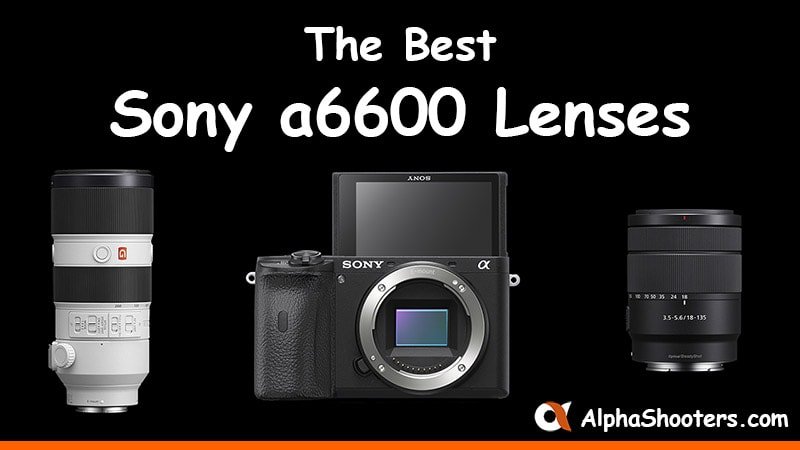
Although this is a guide aimed towards the Sony a6600, the lenses I’m going to cover are supported with all of Sony’s E-mount APS-C cameras along with the full-frame a7 / a9 cameras when shooting in APS-C mode.
Sony A6600 Forum & Facebook Group
If you are looking for further help and advice on the A6600 or would simply like to share your photos and videos, then please head over to our friendly Forum. If you prefer Facebook then I also run the Sony A6600 + A6700 Shooters Group.
Contents
- Top 10 Lenses
- All-in-One Lenses
- Wide-Angle Lenses
- Portrait Lenses
- Macro Lenses
- Telephoto Lenses
- Pancake Lenses
- Budget Lenses
- FAQ’s
- Helpful a6600 Resources
**Please Note: Unless otherwise mentioned no post processing has been applied to the image samples in this guide except for cropping. Full resolution SOOC JPEG images are available to download. RAW files are also available but password protected to help keep my hosting costs sensible. However, I do provide the username/password to all members of our community forum. All images are copyright protected and may be used for personal use only.
Top 10 Sony a6600 Lenses
Here are the top 10 most popular lenses for the Sony a6600 in 2020.
- Sony E 10-18mm F4 OSS
- Rokinon / Samyang 12mm f/2.0 NCS CS
- Sigma 16mm f/1.4 DC DN
- Sony E PZ 18-105mm F4 G OSS
- Sony E 18-135mm F3.5-5.6 OSS
- Sony E 16-55mm F2.8 G
- Sigma 30mm f/1.4 DC DN
- Sigma 56mm f/1.4 DC DN
- Sony FE 85mm F1.8
- Sony FE 90mm F2.8 Macro G OSS
All-in-One Lenses
All-in-one lens generally cover a wide focal range from a moderate wide-angle to short telephoto. They make great travel lenses as you can capture a wide range of subject with just the one single lens and therefore keep your backpack nice and light.
Sony E 16-55mm F2.8 G (SEL1655G)

The Sony E 16-55mm F2.8 G lens is a high quality standard zoom lens with a fast f/2.8 aperture.
Weather sealed and well built, this lens weighs in at only 494g (17.5 oz).
At the maximum aperture of f/2.8 and 16mm the center of the frame is very sharp and the corners look good too. Stop down to f/4 and f/5.6 and you’ll see further improvements in sharpness until you reach f/16.
At 55mm and f/2.8 the center of the frame is very sharp but the corners are a little softer until you step down to f/4.
There is some barrel distortion at 16mm when shooting at f/2.8 but this is gone by around 30mm. If you shoot in JPEG then in-camera corrections will take care of this for you anyway.
The lens does not include Optical Steadyshot but since the a6600 includes in-body-stabilization (IBIS) this shouldn’t be too much of an issue.
An excellent lightweight lens although it does come with a hefty price tag.
To learn more about this lens I’d recommend watching this video from Christopher Frost:
Pros: Well built, fast f/2.8 aperture, bokeh, razor sharp, flare control, quiet autofocus motor
Cons: No stabilization
Recommended Reviews: Christopher Frost (YouTube) | Arthur R (YouTube) | Jason Vong (YouTube)
Sample Photos: Sony Gallery | Flickr
Format: APS-C
Lens Construction: 12 groups, 17 elements
Angle of View: 83°-29°
Aperture Blades: 9 rounded
Minimum Aperture: f/22
Maximum Aperture: f/2.8
Minimum Focusing Distance: 1.09 ft (0.33 m)
Maximum Magnification Ratio: 0.66
Auto Focus: Yes
Stabilization: No
Filter Thread Size: 67mm
Length: 100mm
Diameter: 73mm
Weight: 494g / 17.5 oz
Sony E 18-135mm F3.5-5.6 OSS (SEL18135)
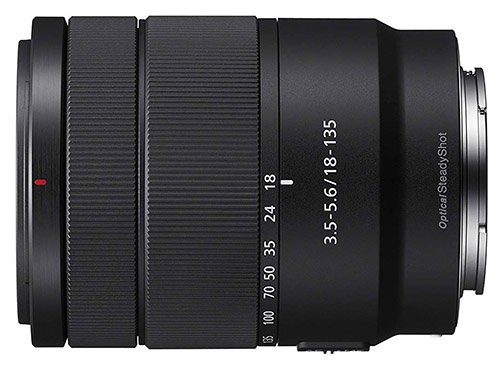
The Sony E 18-135mm F3.5-5.6 OSS is a great choice for the a6600 if you are looking for a lens that covers a very wide focal range from 18mm all the way up to 135mm.
This lens is sharp in the center at 18mm and f/3.5 but the corners are a little softer. However, step down to f/5.6 and now the corners sharpen up nicely. At 135mm central sharpness is excellent and the corners are just a little softer.
There are signs of chromatic aberration but if you are a JPEG shooter in-camera corrections will take care of this for you.
The autofocus motor is fast and silent and Optical Steadyshot (OSS) is built in. The lens is lacking some weather sealing so you’ll need to be a little more careful shooting in the rain with this one.
I own this lens myself so here are a few shots that I’ve taken with it:

Sony E 18-135mm (Shot on a6400) @ 125mm | 1/1000 | f/6.3 | ISO 200 | ** Full Resolution SOOC Download: JPEG | RAW

Sony E 18-135mm (Shot on a6400) @ 120mm | 1/200 | f/8 | ISO 200 | ** Full Resolution SOOC Download: JPEG | RAW

Sony E 18-135mm (Shot on a6400) @ 135mm | 1/1000 | f/5.6 | ISO 3200 | ** Full Resolution SOOC Download: JPEG | RAW
To learn more about this lens I’d recommend watching this video from Christopher Frost:
Pros: Lightweight, well built, bokeh, central sharpness, fast AF
Cons: No weather sealing, poor edge sharpness at 135mm
Recommended Reviews: Technology Mafia (YouTube) | SonyAlphaLab (YouTube) | Christopher Burress (YouTube) | ePhonezine
Sample Photos: My Sample Photos | Flickr
Minimum Focusing Distance: 0.45 m (1.48 ft)
Minimum Aperture: f/22-36
Maximum Aperture: f/3.5-5.6
Aperture Blades: 7
Auto Focus: Yes
Stabilization: Yes
Filter Thread Size: 55mm
Length: 88mm (3-1/2 in.)
Diameter: 67.2mm (2-3/4 in.)
Weight: 325 g (11.5 oz.)
Sony E PZ 18-105mm F4 G OSS (SELP18105G)
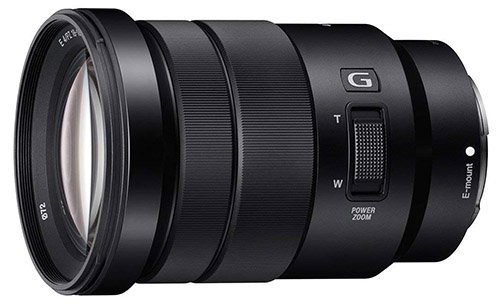
The Sony E PZ 18-105mm F4 G OSS lens is one of Sony’s bestselling standard zoom lenses.
It features a focal range from 18-105mm and a constant aperture of f/4. It also features a motorized internal zoom lens that does not extend as you zoom in. This makes it a very popular choice for video shooters as balancing on a gimbal is so much easier.
The observant among you will notice that Sony also badged this lens as a G lens, meaning this lens has excellent build and optical quality.
It weighs 427g (15.1oz.) so this lens is a good 100g heavier than the 18-135mm, it’s also longer and wider as well.
Optical image stabilization is built in and the autofocus is both fast and virtually silent. The motorized zoom is controlled by a rocker switch on the body itself.
At the maximum aperture of f/4 and 18mm central sharpness is excellent and the corners are just a little softer. Stop down to f/5.6 and you’ll see a small improvement in sharpness and the corners also look a lot better. At 105mm sharpness is excellent in the center of the image but the corners are a little soft.
Chromatic aberrations are visible towards the frame edges along with some vignetting when shooting wide-open, this improves at f/5.6. Distortion is not so well controlled with both barrel and pincushion distortion visible.
I own this lens myself but since purchasing the 18-135mm lens it has just bene collecting dust. The 18-135mm is smaller, lighter, sharper in the center and is definitely my preferred lens for travelling light.
Here are a few shots that I’ve taken with it:
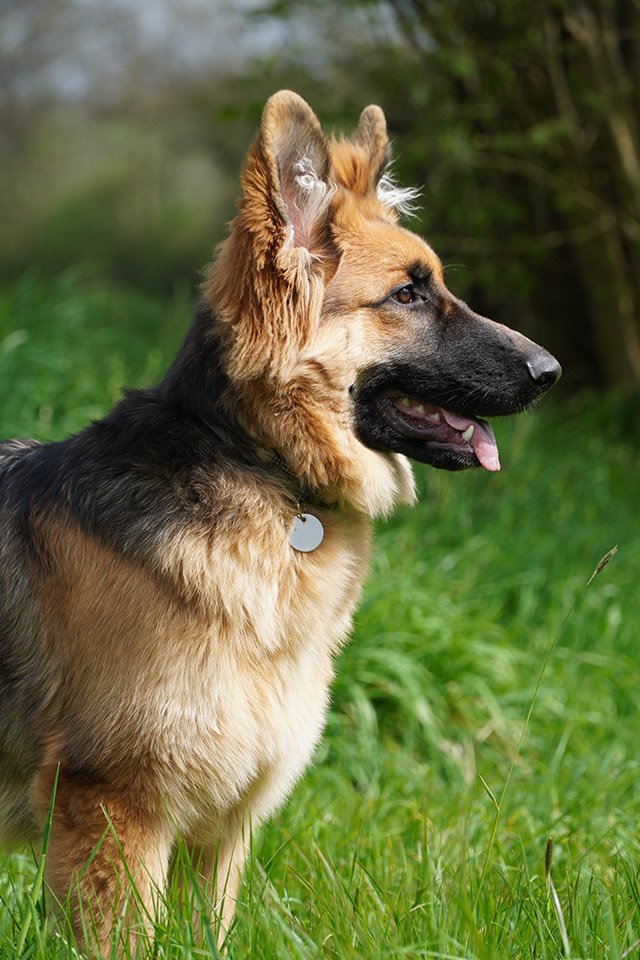
Sony E PZ 18-105mm (Shot on a6400) @ 105mm | 1/1250 | f/4.5 | ISO 250 | Full Resolution SOOC Download: JPEG
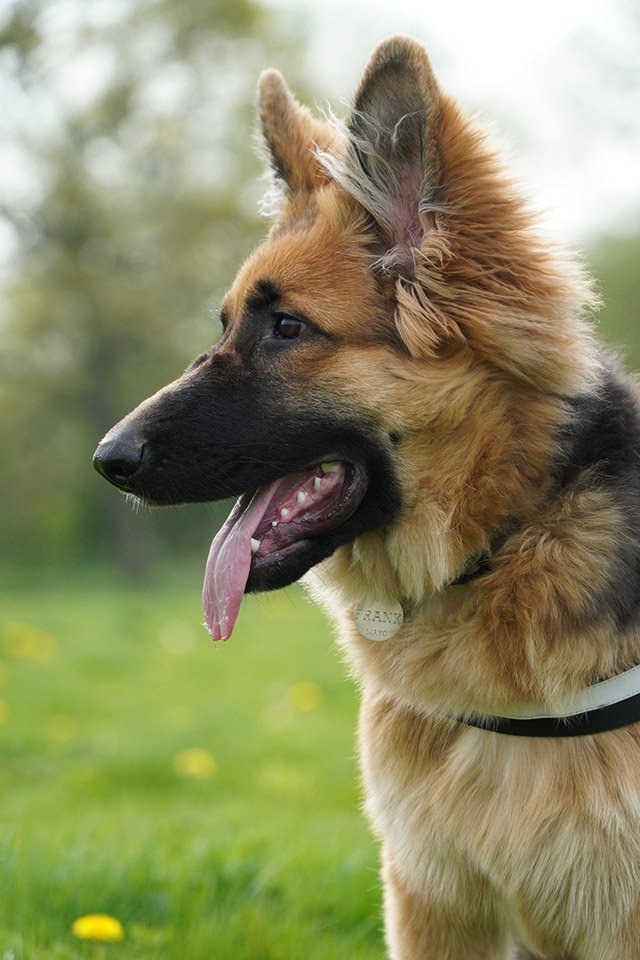
Sony E PZ 18-105mm (Shot on a6400) @ 105mm | 1/1600 | f/4 | ISO 500 | ** Full Resolution SOOC Download: JPEG | RAW
To learn more about this lens I’d recommend watching this video from Christopher Frost:
Pros: Build quality, center sharpness, image stabilization, constant aperture
Cons: Edge sharpness at f/4 not great, CA, distortion at 105mm
Recommended Reviews: Jordan Steele | Christopher Frost (YouTube)
Sample Photos: Flickr
Minimum Focusing Distance: 0.45 (Wide)-0.95m (Tele) (1.48 (Wide)-3.12ft (Tele))
Minimum Aperture: f/22
Maximum Aperture: f/4
Aperture Blades: 7
Auto Focus: Yes
Stabilization: Yes
Filter Thread Size: 72mm
Length: 110mm (4-3/8in.)
Diameter: 78mm (3-1/8 in.)
Weight: 427g (15.1oz.)
Sony E 18–200mm F3.5–6.3 OSS LE (SEL18200LE)

The Sony E 18–200mm F3.5–6.3 OSS LE lens covers a very wide focal range from 18mm at f/3.5 all the way up to 200mm at f/6.3.
The lens is reasonably sharp at 18mm and f/3.5, a little sharper from 50mm-100mm, then at 200mm and f/6.3 sharpness is ok but nothing to shout about. The 18-135 lens is considerably sharper.
There are signs of chromatic aberration at the wide and tele-ends and vignetting is visible at 18mm and f/3.5, stop down to f/5.6 and it clears up. At 200mm and f/6.3 vignetting is again visible, but stop down to f/8 and it’s gone.
Distortion is visible through the focal range but in-camera corrections do a good job at correcting this. If you are shooting into the sun you’ll be glad to know that flare is pretty well controlled.
To learn more about this lens I’d recommend watching this video from John Sison:
Pros: Wide focal range, build quality, central sharpness, flare control
Cons: Vignetting wide-open, distortion, price
Recommended Reviews: James Tan | John Sison (YouTube)
Sample Photos: Flickr
Minimum Focusing Distance: 0.5m (1.64ft)
Minimum Aperture: f/22-40
Maximum Aperture: f/3.5-6.3
Aperture Blades: 7
Auto Focus: Yes
Stabilization: Yes
Filter Thread Size: 62mm
Length: 97.1mm (3-7/8 in.)
Diameter: 68mm (2-3/4 in.)
Weight: 460g (16.3oz.)
Wide-Angle Lenses
Wide-angle lenses allow you to include a lot more of the scene within the frame. Wide-angle lenses are popular choices for landscape, architectural and interior shooters.
Sony E 10-18mm F4 OSS (SEL1018) APS-C Lens
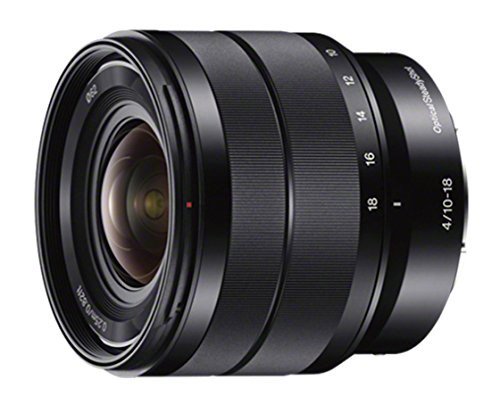
The Sony E 10-18mm F4 OSS is an APS-C lens and also the widest lens that Sony offers with a focal range of 10-18mm and a maximum constant aperture of f/4.
This is a very well built and compact lens that weighs only 225g (8oz.). It’s also a lens that I have owned myself for quite a few years now.
At 10mm and f/4 there is very good central sharpness and the corners are just a little softer. Stop down to f/5.6 and the edges are now much sharper and at f/8 the sharpness is excellent across the frame. The same is true at 18mm.
Chromatic aberrations are well controlled but some purple fringing can be noticed in high contrast shots. Thankfully for JPEG shooting in-camera corrections will take care of this for you.
At 10mm and f/4 vignetting is visible and although stopping down improves this is doesn’t completely go away. Again in-camera corrections do a very good job at correcting this.
Here are a couple of shots that I’ve taken with it:
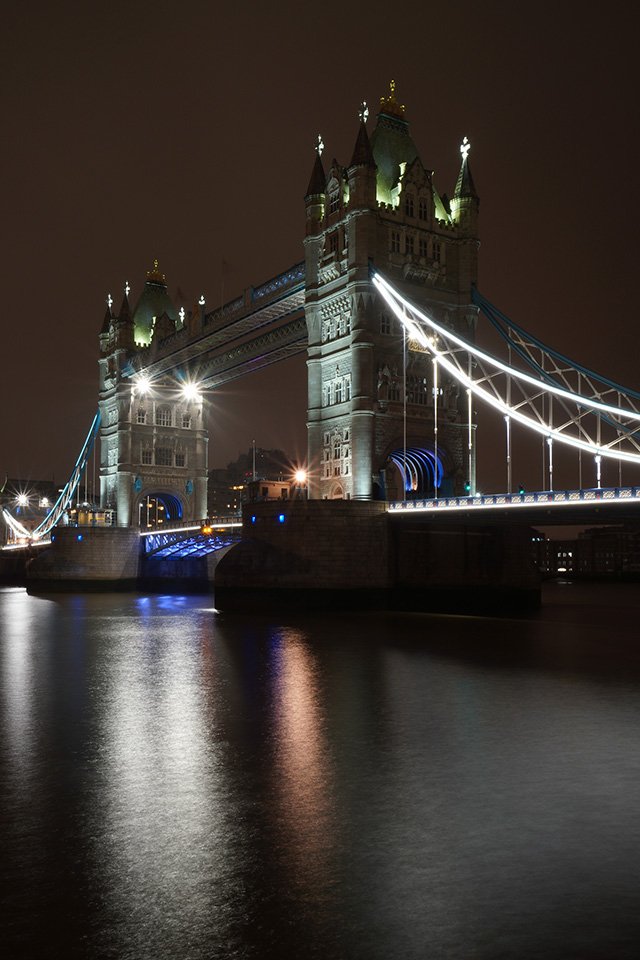
Sony E 10-18mm (Shot on a6400) @ 18mm | 30sec| f/22 | ISO 100 | Cropped | ** Full Resolution SOOC Download: JPEG | RAW
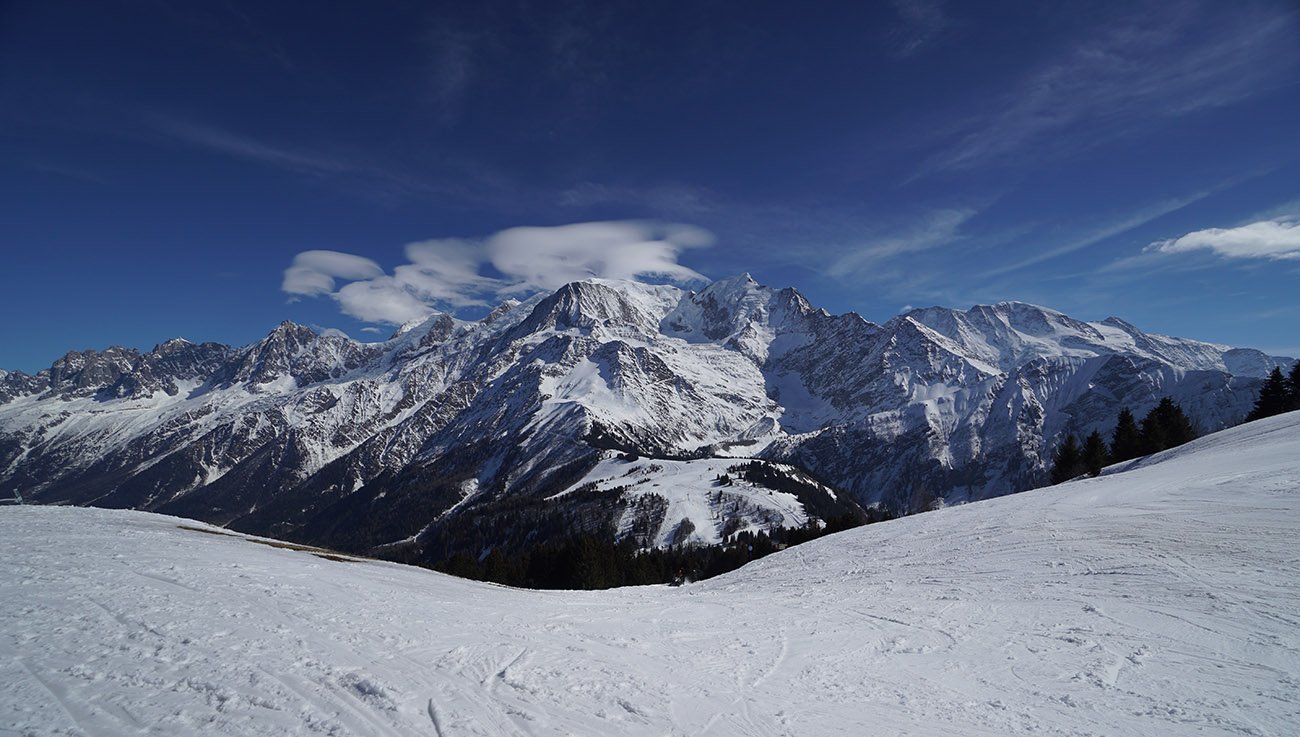
Sony E 10-18mm (Shot on a6500) @ 10mm | 1/400 | f/7.1 | ISO 100 | Handheld | ** Full Resolution SOOC Download: JPEG | RAW
To learn more about this lens I’d recommend watching this video from Arthur R:
Pros: Build quality, low weight, sharpness, distortion, quiet AF motor
Cons: Vignetting, expensive
Recommended Reviews: Drew Robinson | John Sison (YouTube) | Stuck in Customs | SonyAlphaLab
Sample Photos: Flickr
Minimum Focusing Distance: 0.25m (0.82ft)
Minimum Aperture: f/22
Maximum Aperture: f/4
Aperture Blades: 7
Auto Focus: Yes
Stabilization: Yes
Filter Thread Size: 62mm
Length: 63.5mm (2-1/2 in.)
Diameter: 70.0mm (2-7/8 in.)
Weight: 225g (8oz.)
Laowa 9mm f/2.8 Zero-D

The Laowa 9mm f/2.8 Zero-D is the widest lens that you can currently buy for the Sony a6600, it’s also a manual focus only lens.
At the maximum aperture of f/2.8 central sharpness is very good and improves even further when you stop down to f/4 and f/5.6. The corners are a little softer at f/2.8 but they sharpen up nicely by f/5.6.
Chromatic aberration is very well controlled although vignetting at f/2.8 is visible and stepping down to f/11 doesn’t completely eliminate it.
Despite the Zero-D in the name which stands for “Zero Distortion”, there is the smallest amount visible. If you shoot into the sun then you will also notice some flare.
If you plan to point this lens at the stars you’ll be glad to know that coma is well controlled.
Weighing only 215g (7.58oz.) you’ll barely notice this lens mounted to your Sony a6600.
To learn more about this lens I’d recommend watching this video from Christopher Frost:
Pros: Very sharp, low CA, low distortion, compact
Cons: Manual focus only, flare control, vignetting, price
Recommended Reviews: Christopher Frost (YouTube) | Technology Mafia (YouTube) | ePhotoZine
Sample Photos: FlickR
Minimum Focusing Distance: 0.12m (0.39ft)
Minimum Aperture: f/22
Maximum Aperture: f/2.8
Aperture Blades: 7
Auto Focus: No, manual focus only
Stabilization: No.
Filter Thread Size: 49mm
Length: 53mm (2.1 in.)
Diameter: 60mm (2.36 in.)
Weight: 215g (7.58oz.)
Price Check & Buyer Reviews for Laowa 9mm f/2.8 Zero-D
At: Amazon | B&H Photo | Venus Lens
Rokinon / Samyang 12mm f/2.0 NCS CS
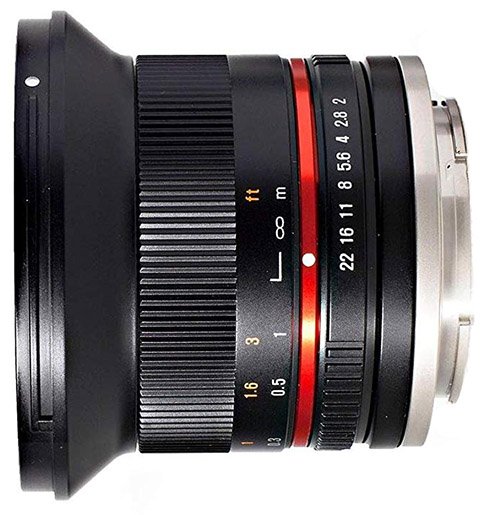
The Rokinon 12mm f/2.0 NCS CS as it’s known in the US, or the Samyang 12mm f/2.0 NCS CS as it’s known in Europe are both identical APS-C lenses from the same company, but for their own branding reasons use the name Rokinon in the US and Samyang in Europe.
Just like the Laowa this is a manual focus only lens but thanks to focus peaking on the a6600 this really shouldn’t be an issue for most shooters. The aperture control is also manually controlled by using the aperture ring on the lens body, you can’t control it with the aperture dial on the a6600 because there are no electrical contacts on the lens.
At f/2 the center of the frame is very sharp and the edges just a little softer. Stop down to f/2.8 and f/4 and sharpness improves even further.
There is some mild barrel distortion and vignetting wide-open at f/2 but this improves by stopping down to f/4.
Coma performance is excellent and when combined with its fast f/2 maximum aperture this is a very popular choice for shooting astrophotography with the Sony a6600.
For the price this lens normally sells for it’s hard to beat this lens right now.
To learn more about this lens I’d recommend watching this video from Christopher Frost:
Pros: Sharpness, build quality, low CA, low coma, price
Cons: Manual focus only
Recommended Reviews: Ian Norman | Jordan Steele | Drew Robinson | Technology Mafia (Youtube)
Sample Photos: Flickr
Minimum Focusing Distance: 0.2m (0.66ft)
Minimum Aperture: f/22
Maximum Aperture: f/2
Aperture Blades: 6
Auto Focus: No, manual focus only
Stabilization: No
Filter Thread Size: 67mm
Length: 59mm (2.32 in.)
Diameter: 72.5mm (2.85 in.)
Weight: 245g (8.64oz.)
Sigma 16mm f/1.4 DC DN
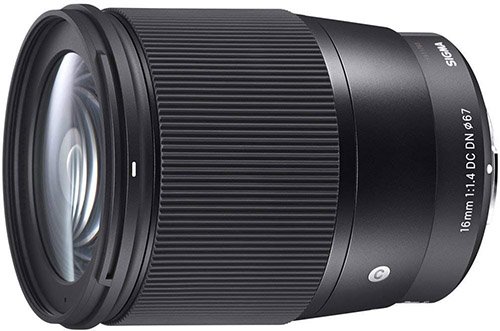
If you are not a fan of manual focus lenses then you’ll be glad to know that the Sigma 16mm f/1.4 DC DN does include an autofocus motor along with a fast maximum aperture of f/1.4.
The lens is well built to Sigma’s usual high standards and weighs 405g (14.3oz). It’s also weather sealed to help prevent dust and moisture getting into both the lens and the a6600 body.
Central sharpness is very good at f/1.4 and f/2 and it becomes even sharper at f/2.8 through to f/8. Diffraction does start to kick in from around f/11 but sharpness still remains good.
There is a small amount of chromatic aberration both centrally and at the edges of the frame, but in-camera corrections soon take care of this.
Flare resistance is very good and the nine bladed aperture produces some very nice sunstars when you step the aperture down.
The autofocus is pretty fast but not the quietest in town.
This lens does unfortunately exhibit some coma. Stars are nice and round in the center of the frame, but closer to the edges they do start to stretch a little. But that still hasn’t stopped this lens from being one of the most popular choices for astrophotography. Here’s a YouTube Review worth watching if you shoot astro and also a Sigma 16mm F1.4 vs Rokinon 12mm F2.0 Comparison for astro.
To learn more about this lens I’d also recommend watching this video from Christopher Frost:
Pros: Sharpness, price, low CA, build quality, flare resistance
Cons: AF motor noise
Recommended Reviews: Dustin Abbott | Technology Mafia (YouTube)
Sample Photos: Flickr
Minimum Focusing Distance: 0.25m (2.07ft)
Minimum Aperture: f/16
Maximum Aperture: f/1.4
Aperture Blades: 9
Auto Focus: Yes
Stabilization: No
Filter Thread Size: 67mm
Length: 92.3mm (3.6 in.)
Diameter: 72.2mm (2.8 in.)
Weight: 405g (14.3oz)
Portrait Lenses
On full-frame 35mm cameras portrait shooters normally prefer a focal length of around 85mm which is effective focal length of around 55mm on an APS-C camera like the a6600. Although environment portrait shooters may choose to go much wider.
Sony E 35mm F1.8 OSS (SEL35F18)

With a focal length of 35mm on an APS-C camera like the Sony a6600, the Sony E 35mm F1.8 OSS lens offers an equivalent focal length on a full-frame camera of around 52mm.
At the maximum aperture of f/1.8 sharpness in the center of the frame is very good, the edges are a little softer but stop down to f/4 to sharpen these up.
Chromatic aberrations are well controlled but there is a small amount of purple fringing when shooting high contrast subjects at f/1.8. In-camera corrections will take care of this for JPEG shooters.
Both distortion and flare are well controlled and the Optical Steadyshot (OSS) helps to stabilize your shots and bring down your shutter speeds. The autofocus motor is not as fast compared to other lenses but it is quiet.
I don’t really shoot people portraits myself so here are a couple of shots of my dog Frank instead:

Sony E 35mm F1.8 (Shot on a6400) @ 35mm | 1/4000 | f/2.8 | ISO 320 | Cropped + Shadows Recovered in LR | ** Full Resolution SOOC Download: JPEG | RAW

Sony E 35mm F1.8 (Shot on a6500) @ 35mm | 1/1250 | f/1.8 | ISO 320 | ** Full Resolution SOOC Download: JPEG | RAW
To learn more about this lens I’d recommend watching this video from Christopher Frost:
Pros: Build quality, size, maximum aperture of f/1.8, silent AF, pleasing bokeh, price
Cons: Slow AF performance, chromatic aberrations
Recommended Reviews: Matthew Durr | Christopher Frost (YouTube)
Sample Photos: Flickr
Minimum Focusing Distance: 0.3m (0.99ft)
Minimum Aperture: f/22
Maximum Aperture: f/1.8
Aperture Blades: 7
Auto Focus: Yes
Stabilization: Yes
Filter Thread Size: 49mm
Length: 45mm (1-13/16 in.)
Diameter: 63mm (2-1/2 in.)
Weight: 154g (5.5oz.)
Sigma 30mm f/1.4 DC DN Contemporary
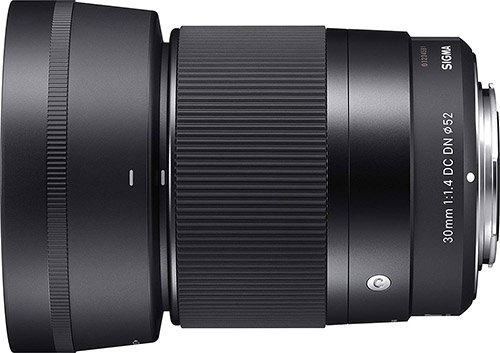
The Sigma 30mm F1.4 DC DN Contemporary lens is one of the sharpest lenses available for Sony E-mount.
It’s sharper and offers better contrast than the more expensive Sony E 35 F1.8 lens above.
At the maximum aperture of f/1.4 this lens is razor sharp in the center of the frame and the corners are just a little softer. Stop down to f/2.8 and the corners soon sharpen up.
There is some vignetting when shooting wide-open but stop down to f/2.8 and you’ll now struggle to notice it.
Chromatic aberrations are visible at f/1.4 but improve as you stop down. These can be corrected in-camera if you are shooting JPEG.
I own this lens myself so here’s a shot of a little tawny owl at a local birds of prey center:

Sigma 30mm F1.4 DC DN (Shot on a6400) @ f/1.4 | 1/400 | ISO 160 | Full Resolution SOOC Download: JPEG | RAW **
To learn more about this lens I’d recommend watching this video from Christopher Frost:
Pros: Sharpness, size, price, bokeh
Cons: Vignetting, distortion
Recommended Reviews: Lavikka Photography (YouTube) | DPReview
Sample Photos: Flickr
Lens Construction: 9 elements in 7 groups
Minimum Focusing Distance: 30cm / 11.8in.
Minimum Aperture: f/16
Maximum Aperture: f/1.4
Aperture Blades: 9 rounded
Auto Focus: Yes
Stabilization: No
Filter Thread Size: 52mm
Length: 73.3㎜ / 2.9in
Diameter: 64.8㎜ / 2.55in.
Weight: 265g/ 9.3oz.
Sony E 50mm F1.8 OSS (SEL50F18)

The Sony 50mm f/1.8 OSS lens is one of the most popular lenses for shooting portraits on the Sony a6600. With a full-frame equivalent focal length of 75mm on the a6600 you are very close to 85mm which many shooters prefer for portraits.
The maximum aperture of f/1.8 really helps to isolate your subject from the background and also produce some very nice bokeh.
The lens is very sharp in the center of the frame and even the corners when shooting wide-open at f/1.8.
A small amount of purple fringing is visible when shooting wide-open but nothing to worry too much about, this can also be quickly corrected in-camera if you are shooting JPEGS. There is a little vignetting at f/1.8 but stop down to f/2.8 and its soon gone.
Distortion is well controlled but if you like shooting into the sun then you might struggle with flare.
To learn more about this lens I’d recommend watching this video from Christopher Frost:
Pros: Sharpness across the frame, build quality, price, bokeh, lightweight
Cons: Slow autofocus in low light
Recommended Reviews: Christopher Frost (YouTube)
Sample Photos: Flickr
Minimum Focusing Distance: 0.39m (1.28ft)
Minimum Aperture: f/22
Maximum Aperture: f/1.8
Aperture Blades: 7
Auto Focus: Yes
Stabilization: Yes
Filter Thread Size: 49mm
Length: 62 mm (2-1/2 in.)
Diameter: 62 mm (2-1/2 in.)
Weight: 202g (7.2oz.)
Sigma 56mm f/1.4 DC DN Contemporary
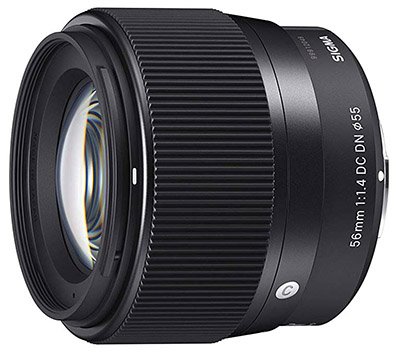
Just like both the Sigma 16mm and the 30mm, the Sigma 56mm f/1.4 DC DN Contemporary lens is well built and extremely sharp.
With an equivalent full-frame focal length of 84mm this is a very popular lens for portrait shooters.
Weighing in at 280g / 9.9oz this lens is only a little heavier than the 30mm lens but is actually the more compact lens despite the extra weight.
Central sharpness is excellent from f/1.4 right through to f/11, and it is still very good even at f/16. The extreme edges are very good from f/1.4 to f/2.8 and excellent from f/4 to f/11. Compared to the Sony E 50mm F1.8 the Sigma is significantly sharper.
Focusing is fast and quiet, flare is well controlled and the bokeh is deliciously smooth.
There is a little chromatic aberration present, mild vignetting and distortion, but in-camera corrections will take care of these for you when shooting JPEGs.
To learn more about this lens I’d recommend watching this video from Christopher Frost:
Pros: Very sharp, price, build quality, bokeh
Cons: Vignetting, CA
Recommended Reviews: Technology Mafia (YouTube) | Camera Labs
Sample Photos: Flickr
Lens Construction: 10 elements in 6 groups
Minimum Focusing Distance: 50cm / 19.7in.
Minimum Aperture: f/16
Maximum Aperture: f/1.4
Aperture Blades: 9 rounded
Auto Focus: Yes
Stabilization: No
Filter Thread Size: 55mm
Length: 59.5mm / 2.3in
Diameter: 66.5mm / 2.6in.
Weight: 280g / 9.9oz.
Sony FE 85mm F1.8 (SEL85F18)
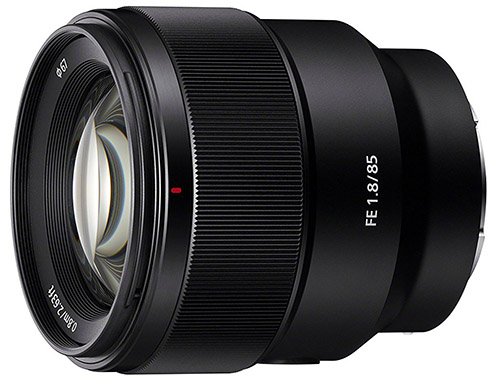
Despite the Sony FE 85mm F1.8 being a full-frame lens it’s still supported and is also a very popular choice for shooting portraits with the a6600.
With a maximum aperture of f/1.8 this lens sucks in a lot of light. It’s very sharp and produces some very nice creamy bokeh.
The autofocus motor is also fast and quiet, it’s actually faster than the Sony FE 85mm F1.4 GM lens which costs around 4x more!
Here’s a shot of my dog Frank at 9 weeks of age and a shot from a portrait workshop that I did, not shot on the a6600 though I’m afraid.

Sony FE 85mm F1.8 (Shot on a7III) @ 85mm | 1/1000 | f/1.8 | ISO 250 | ** Full Resolution SOOC Download: JPEG | RAW

a7R III + FE 85mm F1.8 | @ 1/400 | f/1.8 | ISO 100 | Cropped | ** Full Resolution SOOC Download: JPEG | RAW
To learn more about this lens I’d recommend watching this video from Christopher Frost:
Pros: Build quality, sharpness, bokeh, distortion, price
Cons: Purple fringing at large apertures, flare resistance
Recommended Reviews: Jannik Peters | Christopher Frost (YouTube)
Sample Photos: Flickr
Minimum Focusing Distance: 0.8 m (2.63 ft)
Minimum Aperture: f/22
Maximum Aperture: f/1.8
Aperture Blades: 9 circular
Auto Focus: Yes
Stabilization: No
Filter Thread Size: 67 mm
Length: 82 mm
Diameter: 78 mm
Weight: 371 g (0.82 lbs)
Macro Lenses
Macro lenses are useful for taking photos of very small subjects at very close distances.
A true macro lens should have the ability to focus from infinity to 1:1 magnification at the closest focusing distance, this means that the size of the image in real life is the same size as it is reproduced on a6600’s sensor.
I’ve put together a guide for Sony E-mount macro lenses where you’ll find additional buying advice along with all of the macro lenses available for Sony E-mount.
Here are the most popular macro lenses for the Sony a6600:
Sony E 30mm F3.5 Macro (SEL30M35)
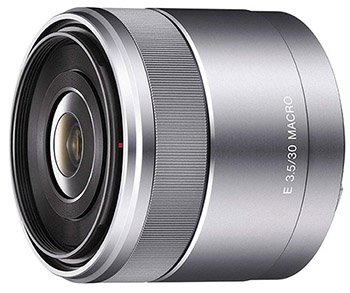
The Sony E 30mm F3.5 Macro APS-C lens is the cheapest macro lens from Son with a 1:1 magnification ratio.
The lens is well built, compact and light in weight but unfortunately it does not have optical image stabilization (OSS) built in, but since the a6600 has IBIS this shouldn’t be an issue..
Central sharpness is very good at f/3.5 and improves down to f/8, whereas the edges are a little softer but for macro work where your subject is normally in the center of your frame this will probably be of no concern. CA is well controlled in the center of the frame, but could be better towards the edges where you will notice some color fringing in high contrast scenes.
The autofocus is fast and quiet, which is definitely important if you don’t want to scare off your subject and prefer to use autofocus than manual focus.
Sadly this lens is only available in silver, so it doesn’t really match the black body of the a6600 particularly well, but maybe this isn’t important to you?
To learn more about this lens I’d recommend watching this video from Arthur R:
Pros: Build quality, size, sharpness, 1:1 magnification, price
Cons: Edge sharpness, small working distance
Recommended Reviews: Technology Mafia (YouTube) | ePhotozine
Sample Photos: Flickr
Maximum Magnification Ration: 1:1
Minimum Focusing Distance: 0.095m (0.32ft)
Minimum Aperture: f/22
Maximum Aperture: f/3.5
Aperture Blades: 7
Auto Focus: Yes
Stabilization: No
Filter Thread Size: 49mm
Length: 55.5 mm (2-1/4in.)
Diameter: 62.0 mm (2-1/2in.)
Weight: 138g (4-7/8oz.)
7Artisans 60mm Macro Lens
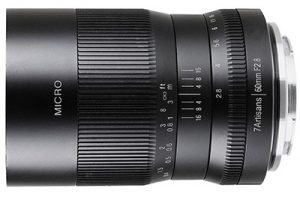
The 7Artisans 60mm Macro is a budget lens that features a minimum 26cm (10in) focusing distance, F2.8 to F16 aperture, 8 elements in 7 groups, a 39mm filter size, de-clicked aperture ring, and 550g (19.4oz) weight.
The lens is made from aluminum alloy and supports extension attachments for shooting 2:1 and 3:1 macro images.
To learn more about this lens I’d recommend watching this video from Arthur R:
Recommended Reviews: Micael Widell (YouTube)
Sample Photos: 7Artisans | Flickr
Maximum Magnification Ration: 1:1
Minimum Focusing Distance: 0.26m (0.85ft)
Minimum Aperture: f/16
Maximum Aperture: f/2.8
Aperture Blades: n/a
Auto Focus: no, manual focus only
Stabilization: no
Filter Thread Size: 39mm
Length: n/a
Diameter: n/a
Weight: 550g (19.4oz.)
Laowa 65mm f/2.8 2x Ultra Macro APO

The Laowa 65mm f/2.8 2x Ultra Macro APO lens in the only macro lens on the market that is capable of producing 2X life-size images.
Both the focusing and aperture control is manual only, so if you rely on autofocus this probably isn’t the best lens for you. Although focus peaking on the a6600 really makes manual focusing a breeze.
The lens has excellent build quality and is very sharp wide-open at f/2.8 in the center even at 2x. The corners are a little softer wide-open but soon sharpen up at f/4. At 2x magnification the lens does start to get softer at f/5.6.
Chromatic aberration, distortion and vignetting are very well controlled even at f/2.8 although the lens is prone to flaring.
To learn more about this lens I’d recommend watching this video from Christopher Frost:
Recommended Reviews: Christopher Frost (YouTube) | Dustin Abbott
Sample Photos: Venus Lens
Maximum Magnification Ration: 2:1
Minimum Focusing Distance: 17cm / 6.69 in. (2X)
Minimum Aperture: f/22
Maximum Aperture: f/2.8
Aperture Blades: 9
Auto Focus: No, manual focus only
Stabilization: No
Filter Thread Size: 52mm
Length: 100mm
Diameter: 57mm
Weight: 335g / 11.81oz
Price Check & Buyer Reviews for Laowa 65mm F2.8 2x Ultra Macro APO
At: Amazon | B&H Photo | Venus Lens
Sony FE 90mm F2.8 Macro G OSS (SEL90M28G)

The Sony FE 90mm f/2.8 Macro G OSS lens is a full-frame lens and one of the sharpest lenses that Sony has ever built. DxOMark reviewed this lens and said that it’s outstanding, scoring higher marks than both the Canon and Nikon equivalents.
It’s not easy to find fault with this lens but I do have a couple of issues with it. First the autofocus motor is not all that fast, nor is it particularly quiet. Second is that the manual focus ring goes from 1:1 to infinity with a very short throw, which sometimes makes it a little tricky to fine tune the focus.
This lens is also a popular choice for portrait shooters thanks to its sharpness and very please bokeh.
I own this lens myself so here are a couple of shots that I have taken with it:

Sony FE 90mm F2.8 Macro (Shot on a6400) @ 1/250 | f/2.8 | ISO 400 | ** Full Resolution SOOC Download: JPEG | RAW

Sony FE 90mm F2.8 Macro (Shot on a6400) @ 1/250 | f/2.8 | ISO 1250 | Cropped | ** Full Resolution SOOC Download: JPEG | RAW

Sony FE 90mm F2.8 Macro (Shot on a7R III) @ 1/500 | f/2.8 | ISO 320 | Cropped | ** Full Resolution SOOC Download: JPEG | RAW
To learn more about this lens I’d recommend watching this video from Shane Bethlehem:
Pros: Incredible sharpness at all apertures, excellent color rendition, CA is well controlled, very well built, price
Cons: Autofocus isn’t the fastest, manual focus could allow for finer adjustments
Recommended Reviews: Jordan Steele | DxOMark | Philip Reeve
Sample Photos: Flickr
Maximum Magnification Ration: 1:1
Minimum Focusing Distance: 0.28 m (0.92 ft)
Minimum Aperture: f/22
Maximum Aperture: f/2.8
Aperture Blades: 9 circular
Auto Focus: Yes
Stabilization: Yes
Filter Thread Size: 62 mm
Length: 130.5 mm
Diameter: 79 mm
Weight: 602g (21.23 oz.)
Sigma 70mm F2.8 DG Macro Art
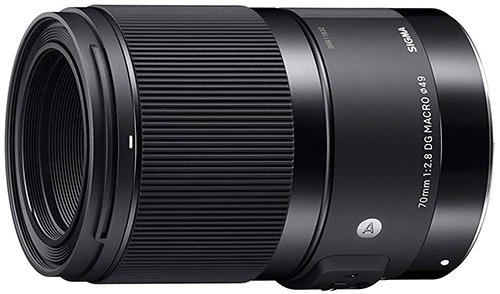
The Sigma 70mm F2.8 DG Macro lens for Sony E-mount (full-frame) has been adapted from Sigma’s DSLR version of this lens.
The lens is built to Sigma’s usual high standards when it comes to their Art Series of lenses. This was actually the first Sigma lens that I have bought and my first impression as I removed it from the box was how nice it felt in my hands.
This lens is capable of producing some very sharp images even at f/2.8, chromatic aberration is well controlled and so is distortion.
The autofocus motor on this lens is definitely not the fastest, but I don’t find this to be a big concern since I’m using manual focus for most of my macro shots. The focus ring provides a lot more precision than the one found on the Sony 90mm Macro, although possibly a little too much because it needs around 10 twists of the wrist to go from minimum to maximum distance.
Unlike the Sony 90mm this lens does extend when you focus although I’ve never found it to be an issue.
With a minimum focusing distance of 0.25m you’ll need to get pretty close to your subject for 1:1 images, this can also sometimes result in the lens hood casting a shadow on your subject depending on the angle that the light is coming from.
Here are a couple of shots that I have taken with it:

Sigma 70mm F2.8 Macro (Shot on a6500) @ 1/250 | f/8 | ISO 160 | Cropped | ** Full Resolution SOOC Download: JPEG | RAW
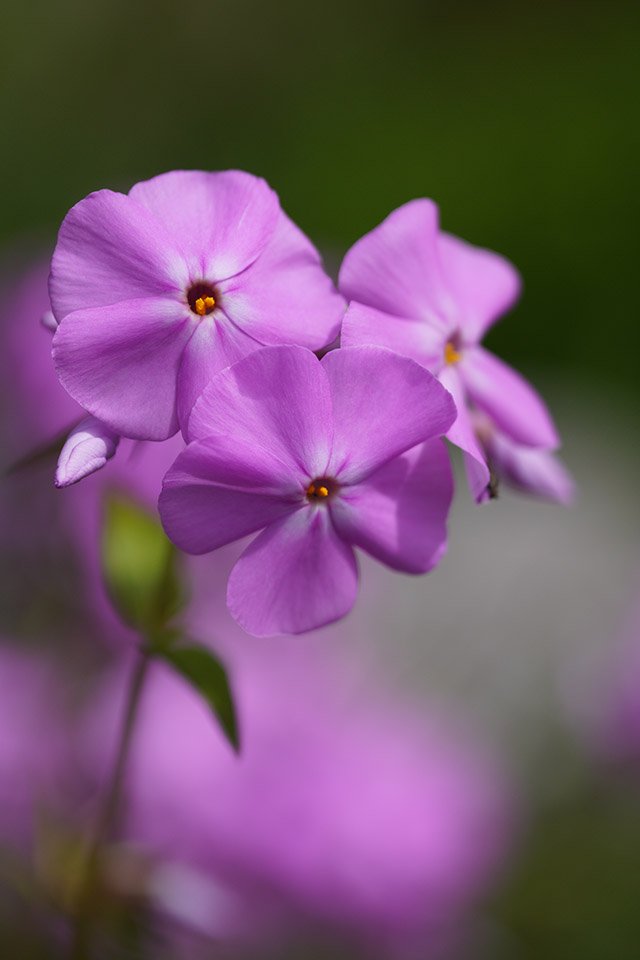
Sony a6400 + Sigma 70mm F2.8 DG Macro Art @ 1/4000 | f/2.8 | ISO 125 | Full Resolution SOOC Download: JPEG | RAW **
For a closer look at this lens I’d recommend this review from Christopher Frost. Although he’s reviewing the Canon version of this lens other than the mount it’s pretty much identical to the Sony E-mount version so it’s still useful to watch:
Pros: Extremely sharp, color rendition, chromatic aberration, build quality, price
Cons: Autofocus, manual focus ring
Recommended Reviews: My Review
Sample Photos: My Review
Maximum Magnification Ratio: 1:1
Minimum Focusing Distance: 0.25m (0.82ft)
Minimum Aperture: f/22
Maximum Aperture: f/2.8
Aperture Blades: 9 circular
Auto Focus: Yes
Stabilization: No
Filter Thread Size: 49 mm
Length: 130 mm (min) 181 mm (max)
Diameter: 70.8 mm
Weight: 622 g (1.37 lbs) with lens hood
Telephoto Lenses
If you enjoy shooting sports or wildlife then you’ll probably want to invest in a telephoto lens.
The longest APS-C telephoto lens for Sony E-mount today is 350mm, if you want a longer focal length than this then you’ll need to look at full-frame telephoto lenses which go up to 600mm.
Sony E 55-210mm F4.5-6.3 OSS (SEL55210)
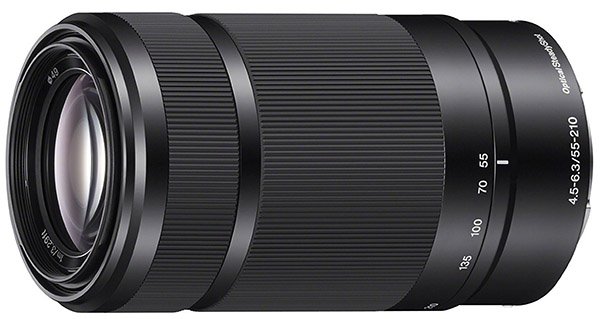
The Sony E 55-210mm F4.5-6.3 OSS lens covers a very useful focal range and also comes with a very friendly price sticker.
I own this lens myself and it’s definitely seen quite a bit of use!
Build quality is very good and the autofocus is fast, accurate and virtually silent. Optical Steadyshot (OSS) is also very helpful for shooting handheld especially at 210mm when even the smallest of shakes becomes visible.
Between 55mm and 120mm the lens is reasonably sharp in the center of the frame when shooting wide-open, the corners are a little softer but stepping down a stop will sharpen them up. At 210mm the center is a little softer but will still be sharp enough to make most shooters happy.
There is some vignetting visible along with chromatic aberrations when shooting wide-open, but the in-camera corrections do a great job at fixing this.
The autofocus motor works really well in good light, but it will start to struggle as the light levels drop.
Here are a few shots that I have taken with it:
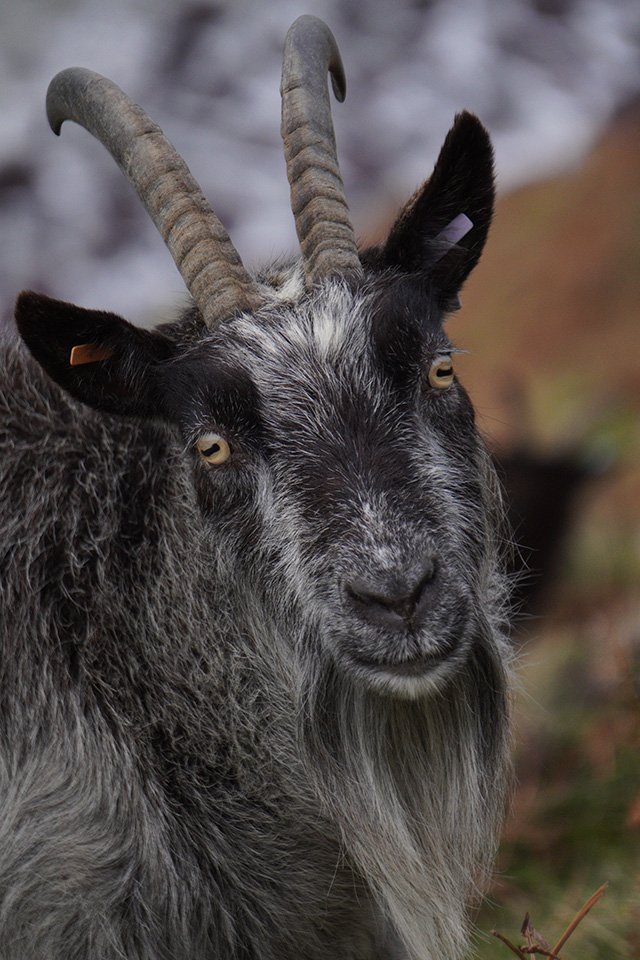
Sony E 55-210mm (Shot on a6400) @ 210mm | 1/1000 | f/6.3 | ISO 1000 | Handheld | ** Full Resolution SOOC Download: JPEG | RAW
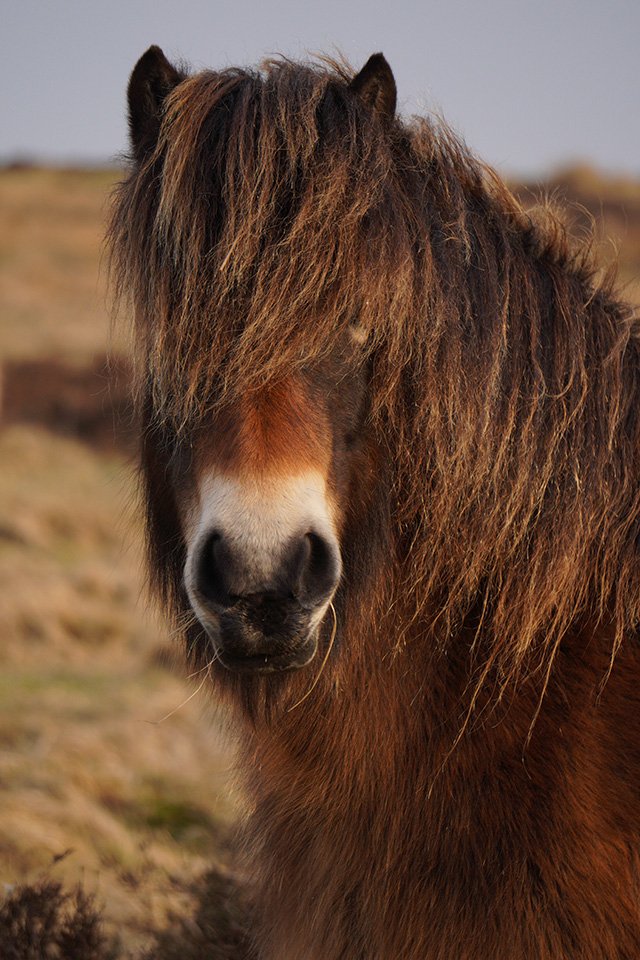
Sony E 55-210mm (Shot on a6400) @ 150mm | 1/640 | f/5.6 | ISO 400 | Handheld | ** Full Resolution SOOC Download: JPEG | RAW
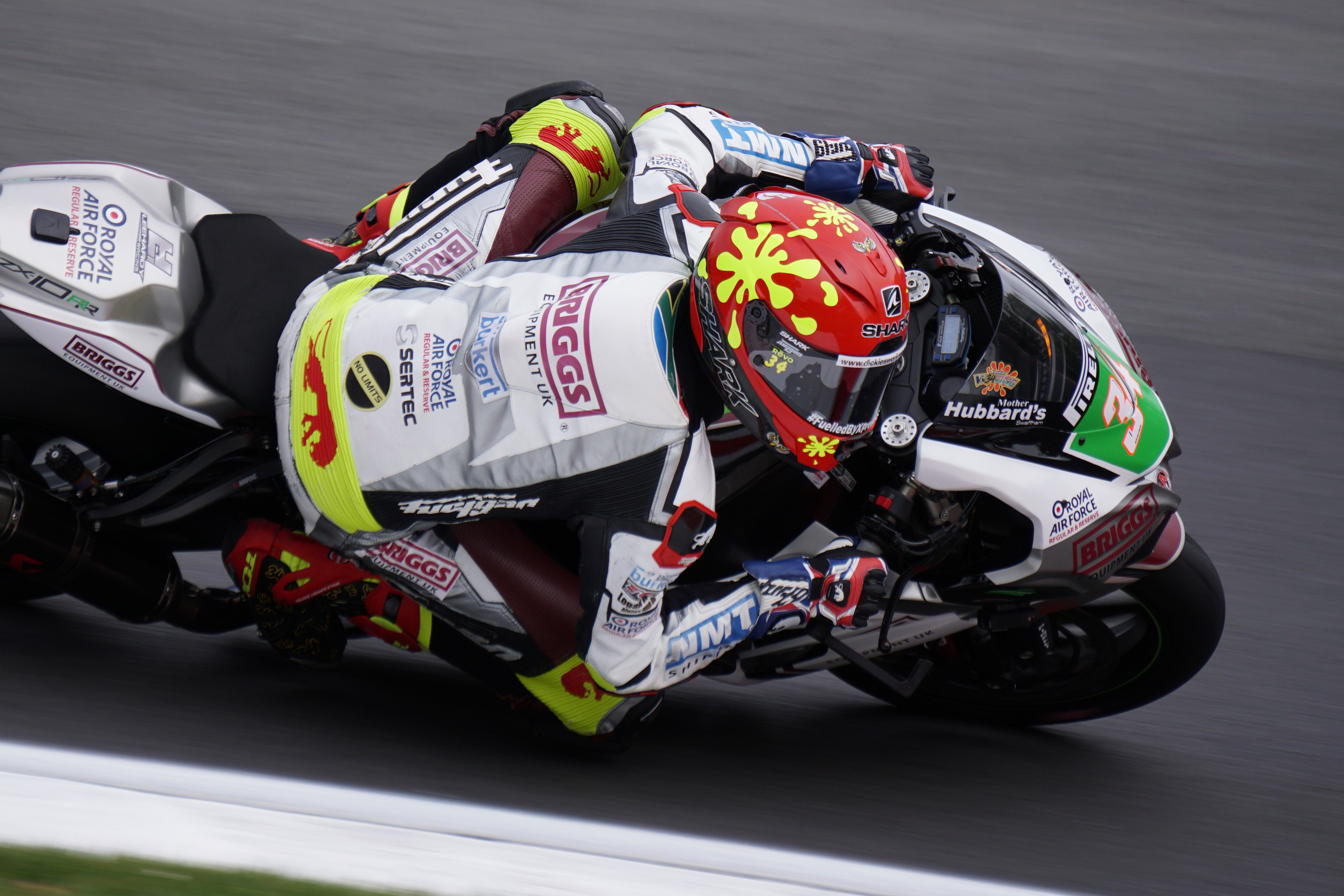
Sony E 55-210mm (Shot on a6500) @ 210mm | 1/250 | f/6.3 | ISO 200
To learn more about this lens I’d recommend watching this video from Christopher Frost:
Pros: Price, central sharpness, weight, autofocus performance
Cons: CA, vignetting
Recommended Reviews: Jay SonyAlphaLab | Technology Mafia (YouTube) | John Sison (YouTube)
Sample Photos: Flickr
Minimum Focusing Distance: 1m (3.28ft)
Minimum Aperture: f/22-32
Maximum Aperture: f/4.5-6.3
Aperture Blades: 7
Auto Focus: Yes
Stabilization: Yes
Filter Thread Size: 49mm
Length: 108mm (4-3/8 in.)
Diameter: 63.8mm (2-5/8 in.)
Weight: 345g (12.2oz.)
Sony E 70-350mm F4.5-6.3 G OSS (SEL70350G)

The Sony E 70-350mm F4.5-6.3 G OSS is currently the longest APS-C zoom lens that you can buy for the Sony a6600.
I’ve not owned this lens for very long but I have been impressed by its compact size, weight and autofocus performance. It is a variable aperture lens and the maximum aperture at 350mm is f/6.3.
I have to admit to being a little disappointed that Sony decided not to include a focus limiter switch that you do find on the Sony FE 70-300 full-frame lens, but it’s not a major issue unless you make use of this often.
I decided to compare the autofocus performance of this lens with the Sony FE 70-300 and found they both offer similar levels of performance.
Here are a few sample photos that I’ve shot with this lens:
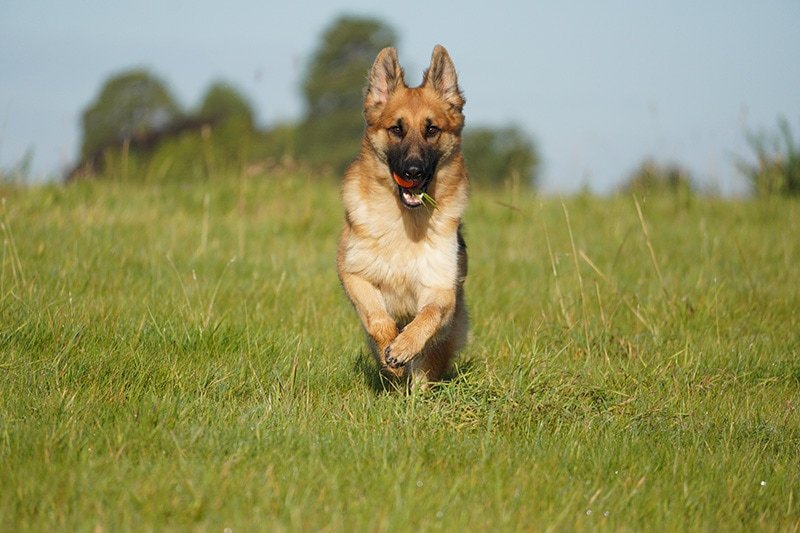
Sony a6400 + E 70-350 @ 350mm | 1/2000 | f/6.3 | ISO 500 | Full Resolution SOOC Download: JPEG | RAW **
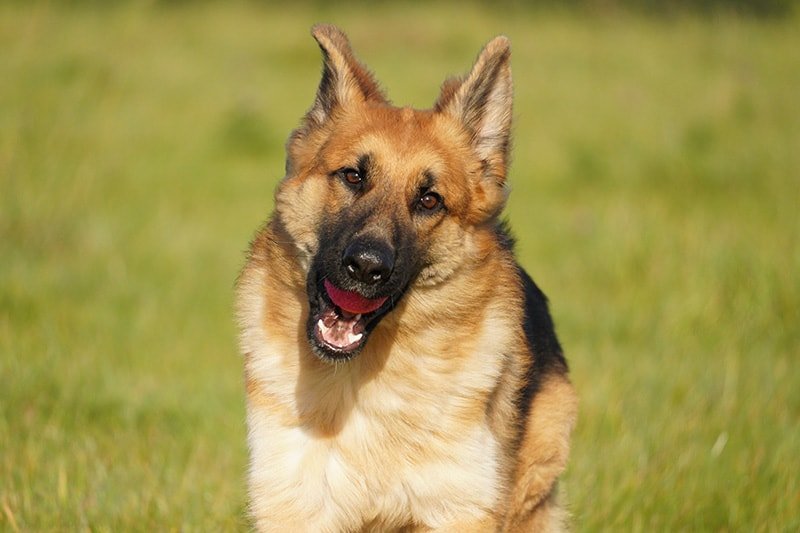
Sony a6400 + E 70-350 @ 350mm | 1/2000 | f/6.3 | ISO 640 | Full Resolution SOOC Download: JPEG | RAW **

Sony a6400 + E 70-350 @ 210mm | 1/2000 | f/6.3 | ISO 1000 | Cropped | Full Resolution SOOC Download: JPEG | RAW **
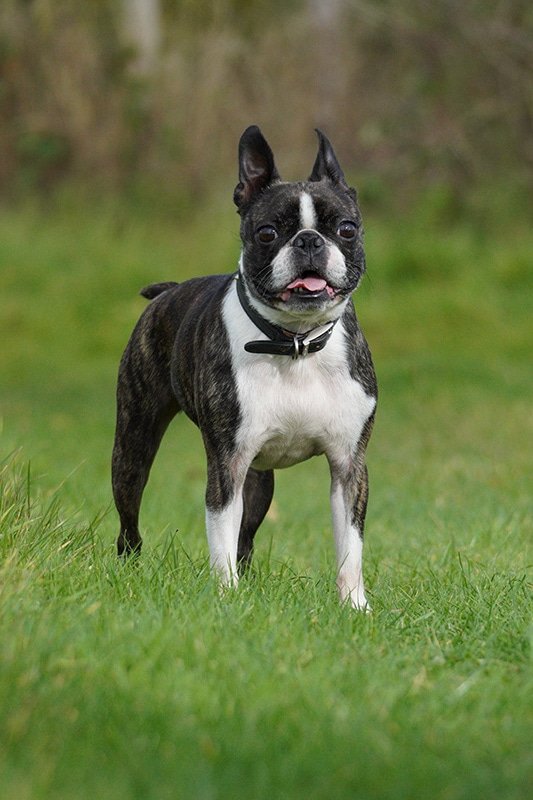
Sony a6400 + E 70-350 @ 160mm | 1/2000 | f/5.6 | ISO 1000 | Cropped | Full Resolution SOOC Download: JPEG | RAW **
And here’s one I shot with this lens on my a7R IV in crop mode:
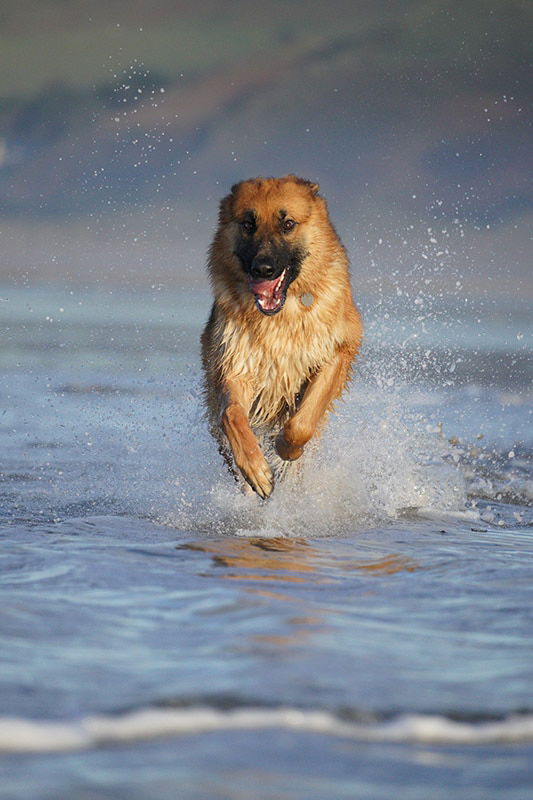
Sony a7R IV + E 70-350 G @ 350mm | 1/2000 | f/6.3 | ISO 1000 | Full Resolution SOOC Download: JPEG | RAW **
This lens has quickly become one of my favourite telephoto lenses for APS-C cameras like the Sony a6600.
To learn more about this lens I’d recommend watching this video from Christopher Frost:
Pros: Very fast and quiet autofocus, lightweight and compact, sharpness
Cons: No focus limiter or panning modes
Recommended Reviews: Christopher Frost (Youtube) | Arthur R (YouTube)
Sample Photos: Sony Gallery
Format: APS-C
Lens Construction: 13 groups, 19 elements
Angle of View: 22°-4°40′
Aperture Blades: 7 circular
Minimum Aperture: f/4.5-6.3
Maximum Aperture: f/22-32
Minimum Focusing Distance: 3.61–4.93 ft (1.1–1.5 m)
Maximum Magnification Ratio: 0.75
Auto Focus: Yes
Stabilization: Yes
Filter Thread Size: 67mm
Length: 142mm
Diameter: 77mm
Weight: 625g / 22.1 oz
Sony FE F4.5-5.6 100-400mm G Master (SEL100400GM)
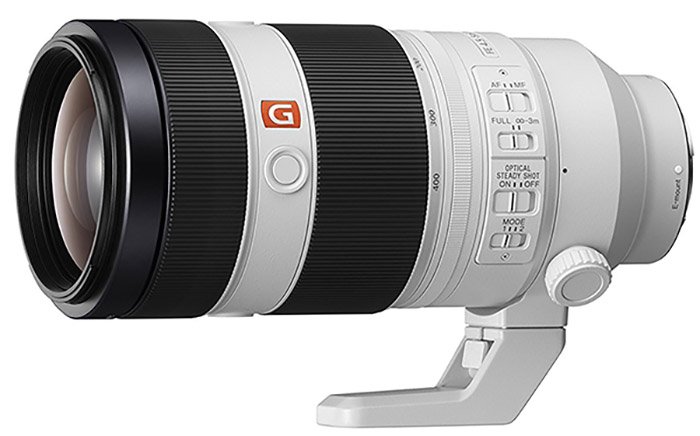
The Sony FE 100-400mm f/4.5-5.6 GM OSS lens is a full-frame lens but it’s also one of the most popular telephoto choices for APS-C shooters since it gives you a full-frame equivalent focal length of 150-600mm.
I bought this lens on the first day that it was released and since then it’s spent more time attached to my cameras than any other lens I own.
The lens has a variable aperture of F4.5-5.6, an extremely fast and silent autofocus motor, and Sony’s G Master build quality. The lens is also weather sealed against dust and moisture.
Sharpness across the frame is exceptional and DxOMark rate this as the sharpest lens in the 100-400mm focal range, beating both Canon and Nikon equivalents.
Chromatic aberrations are extremely well controlled along with flare, although there are signs of vignetting at 400mm but the in-camera corrections take care of this.
If 400mm isn’t long enough then you’ll be pleased to know that both the Sony FE 1.4x and 2.0x teleconverters are supported with this lens. However, I’d only recommend using it with the 1.4x since with the 2x your aperture is stopped down to f/11 and you’ll find that the images are a little on the softer side and AF performance also takes a hit.
Here are a few shots that I have taken with it:
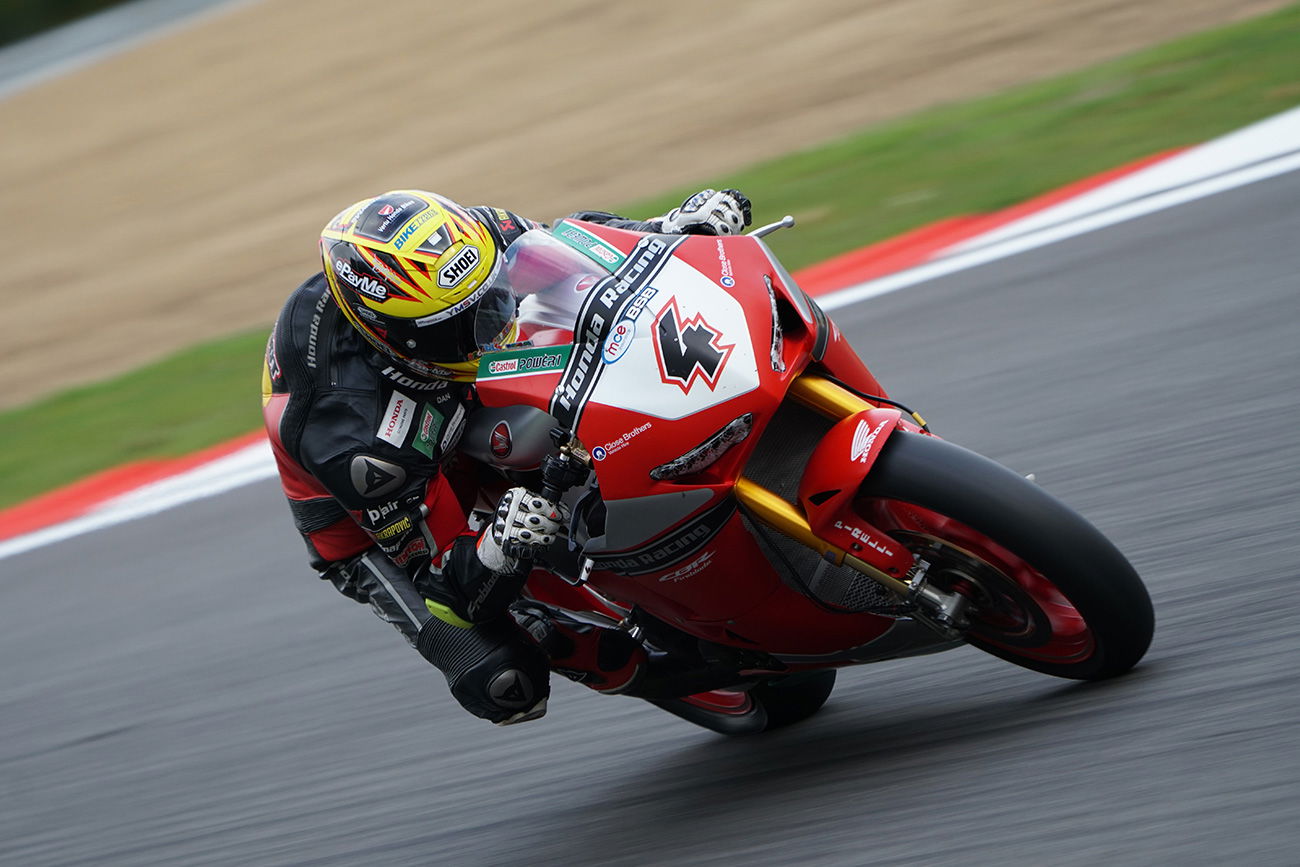
a6500 + 100-400 GM @ 345mm | 1/250 | f/5.6 | ISO 400 (I don’t provide full res images for superbike shots I’m afraid)

a9 + 100-400 GM @ 400mm | 1/1600 | f/5.6 | ISO 200 | Cropped | *Full Resolution Download: JPEG | RAW
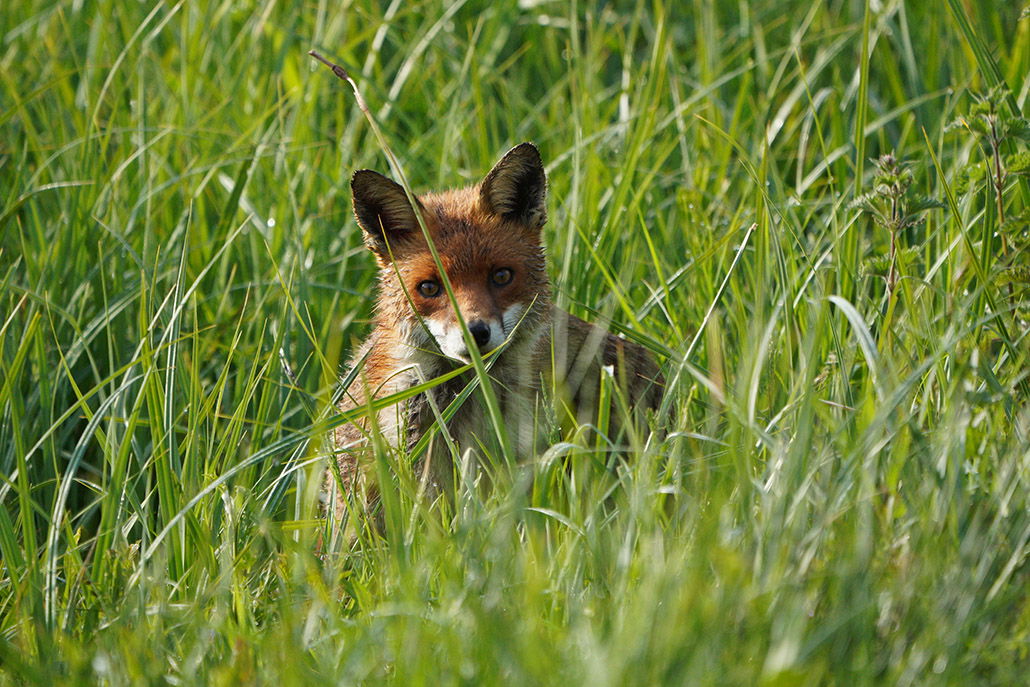
Sony a6400 + 100-400mm GM @ 400mm | 1/1250 | f/5.6 | ISO 800 | Full Resolution SOOC Download: JPEG
To learn more about this lens I’d recommend watching this video from Jay:
Pros: Fast autofocus, very sharp across the frame, color rendition, bokeh, build quality
Cons: Price
Recommended Reviews: My Review | DxOMark
Sample Photos: My Review Samples
Minimum Focusing Distance: 0.98 m (3.22 ft)
Minimum Aperture: f/32-40
Maximum Aperture: f/4.5-5.6
Aperture Blades: 9 circular
Auto Focus: Yes
Stabilization: Yes
Filter Thread Size: 77 mm
Length: 205 mm
Diameter: 93.9 mm
Weight: 1395 g (3.1 lbs) without tripod mount
Sony FE 200-600mm F5.6-6.3 G OSS (SEL200600G) Lens

The Sony FE 200-600mm F5.6-6.3 G OSS lens is the longest lens that you can currently mount to your Sony a6600..
Since I enjoy shooting wildlife myself I ordered this lens as soon as it was announced and I’m currently working on a 200-600 vs 100-400 comparison.
With a focal range of 200-600mm and a maximum aperture of f/6.3 at 600mm this lens will help you to get closer to wildlife than ever before. If 600mm is not long enough then you can also add the 1.4x or 2.0x teleconverters.
This is a big lens and it weighs 2115g without tripod mount and is 318mm in length. It’s also an internal focusing lens and the short zoom throw makes going from 200mm to 600mm a breeze. Because it doesn’t extend it also balances very well on a gimbal.
At 600mm this lens is sharper than the Sony FE 100-400 + 1.4x is at 560mm. At 400mm this lens is also a touch sharper than the 100-400 which considering it’s a G lens and not a GM lens is really quite something.

Sony a7 III + 200-600 @ 600mm | 1/1000 | f/6.3 | ISO 640 | Full Resolution SOOC Download: JPEG | RAW **

Sony a7III + 200-600 @ 600mm | 1/2000 | f/6.3 | ISO 640 | Cropped | Full Resolution SOOC Download: JPEG
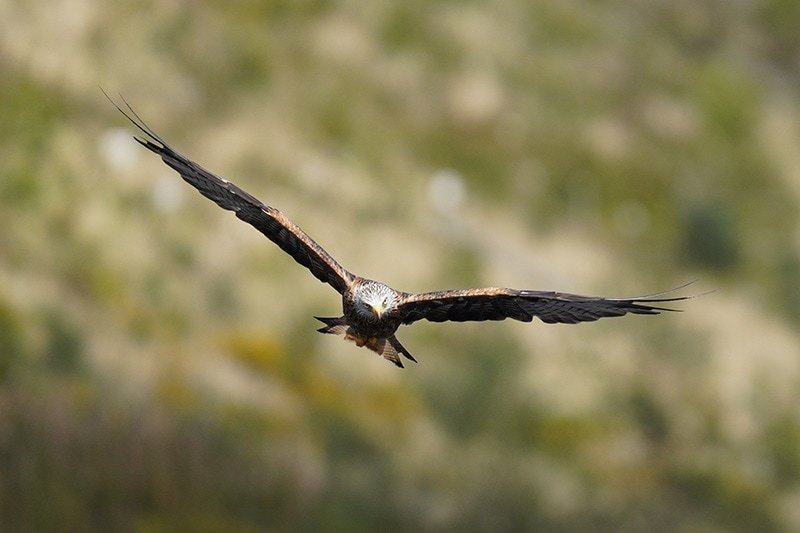
Sony a7III + 200-600 @ 600mm | 1/2000 | f/6.3 | ISO 800 | Cropped | Full Resolution SOOC Download: JPEG | RAW **
To learn more about this lens I’d recommend watching this video from Jay:
Pros: Internal zoom, sharpness, 1.4x & 2.0x teleconverter compatibility
Cons: Size, weight
Recommended Reviews: Mark Smith (YouTube)
Sample Photos: My Sample Gallery
Minimum Focusing Distance: 2.4m (7.88 ft)
Minimum Aperture: 32-36
Maximum Aperture: 5.6-6.3
Aperture Blades: 11 circular
Auto Focus: Yes
Stabilization: Yes
Filter Thread Size: 95mm
Length: 318 mm (12 5/8 in.)
Diameter: 111.5 mm (4 1/2 in.)
Weight: 2115g without tripod mount
Sigma 100-400mm F5-6.3 DG DN OS
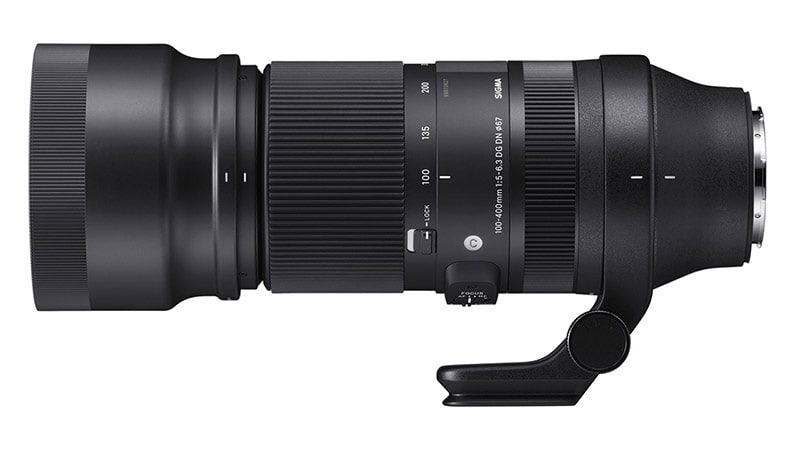
The Sigma 100-400mm F5-6.3 DG DN OS has not long been released, as soon as reliable information is known about this lens this section will be updated.
I have purchased this lens myself and the image quality is very good and extremely close to the Sony FE 100-400 lens.
Unfortunately the autofocus performance is not on par with the Sony. It misses more shots and if you are shooting bursts with AF-C priority set to balanced emphasis it struggles sometimes to lock-on and fire the shutter.
I will be doing a full review and comparison with the Sony FE 100-400 GM lens very soon.
Until then this first look video from Gordon Laing is worth watching:
Pros:
Cons:
Recommended Reviews:
Sample Photos: Sigma Gallery
Lens Construction: 22 elements in 16 groups
Angle of View (35mm): 24.4° – 6.2°
Aperture Blades: 9 rounded
Minimum Aperture: f/22-29
Maximum Aperture: f/5
Minimum Focusing Distance: 112 (Wide) – 160cm (Tele) / 44.1 – 63in.
Maximum Magnification Ratio: 1:4.1 (400mm)
Auto Focus: Yes
Stabilization: Yes
Filter Thread Size: 67mm
Length: 199.2mm / 7.8in.
Diameter: 86mm / 3.4in.
Weight: 1,140g / 40.2oz.
Website: Sigma 100-400mm F5-6.3 DG DN OS
Pancake Lenses
A pancake lens is looks just like an actual pancake, flat and thin! They normally have a relatively wide focal length as well. Pancake lenses are often the first choice of street shooters because they are so discrete.
Sony E 20mm F2.8 (SEL20F28)
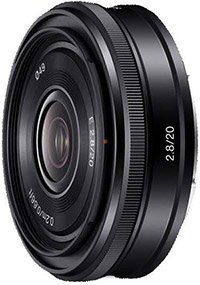
As the photo above shows, the Sony E 20mm F2.8 lens is very thin indeed! It weighs only 69 grams (2.4oz) and is 20.4mm in length.
Sharpness in the center of the frame is good when shooting at the maximum aperture of f/2.8 and the edges although a little softer are still perfectly respectable. Stopping down to f/5.6 improves sharpness a little further.
Chromatic aberrations are visible towards the frame edges when shooting at f/2.8 as is vignetting, you’ll need to stop down to f/8 to see a big improvement here.
There is some barrel distortion visible but in-camera corrections do a great job of fixing this when shooting JPEGs. Flare control is very good even when pointing this lens directly into the sun.
To learn more about this lens I’d recommend watching this video from Christopher Frost:
Pros: Size, weight, central sharpness wide-open
Cons: Chromatic aberrations, vignetting, distortion
Recommended Reviews:
Sample Photos: Flickr
Minimum Focusing Distance: 0.66 ft (0.2 m)
Minimum Aperture: f/16
Maximum Aperture: f/2.8
Aperture Blades: 7 rounded
Auto Focus: Yes
Stabilization: No
Filter Thread Size: 49mm
Length: 13/16″ (20.4 mm)
Diameter: 2-1/2 (62.6 mm)
Weight: 2.4 oz (69 g)
Budget Lenses
If you are on a budget then take a closer look at some of these lenses from 7Artisans:
- 7Artisans 7.5mm f/2.8
- 7Artisans 12mm f/2.8
- 7Artisans 25mm f/1.8
- 7Artisans 35mm f/1.2
- 7Artisans 35mm f/2.0
- 7Artisans 50mm f/1.8
- 7Artisans 55mm f/1.4
- 7Artisans 60mm f/2.8 Macro
Sony a6600 FAQs
The Sony a6600 has an APS-C sized sensor and uses the Sony E-mount system. It’s compatible with any of Sony’s E-mount lenses and also third-party lenses that use the E-mount.
One of the most popular travel lenses for the Sony a6600 is the Sony E 18-135mm F3.5-5.6 OSS lens. Its compact and lightweight and covers a very wide focal range from 18mm all the way to 135mm.
The Sony E 20mm F2.8 is one of the smallest pancake lenses available for the Sony a6600.
There are quite a few good choices but one of the most popular is the Rokinon / Samyang 12mm f/2.0 NCS CS.
Yes full-Frame E-mount lenses are supported on the Sony a6600.
If you shoot mainly still images or stills and just a little video then I’d recommend the 18-135. It’s lighter, sharper, has a smaller minimum focus distance so is great for macro shots and you can zoom in and out much faster with the manual zoom. If you shoot more video then the 18-105 is the better option since you get a constant f/4 aperture, power zoom, and it’s much easier to balance on a gimbal because it’s an internal zoom which does not extend.
There are many great prime lenses covered in this guide, but my personal 3 favorite primes are the three excellent Sigma’s – the 16mm F1.4, 30mm F1.4 and the 56mm F1.4.
The Sony a6600 uses the Sony FP-FZ100 rechargeable battery.
The best place to ask questions is in our Sony a6600 Shooters Group on Facebook. If you are not on Facebook then drop a comment below and I’ll do my best to help.
Additional Lens Guides
Sony A6600 Forum & Facebook Group
If you are looking for further help and advice on the A6600 or would simply like to share your photos and videos, then please head over to our friendly Forum. If you prefer Facebook then I also run the Sony A6600 + A6700 Shooters Group.

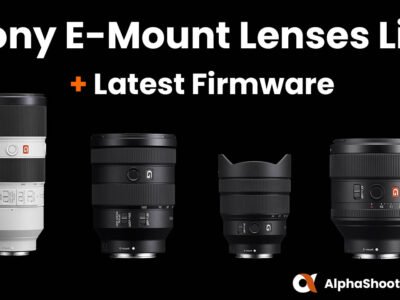

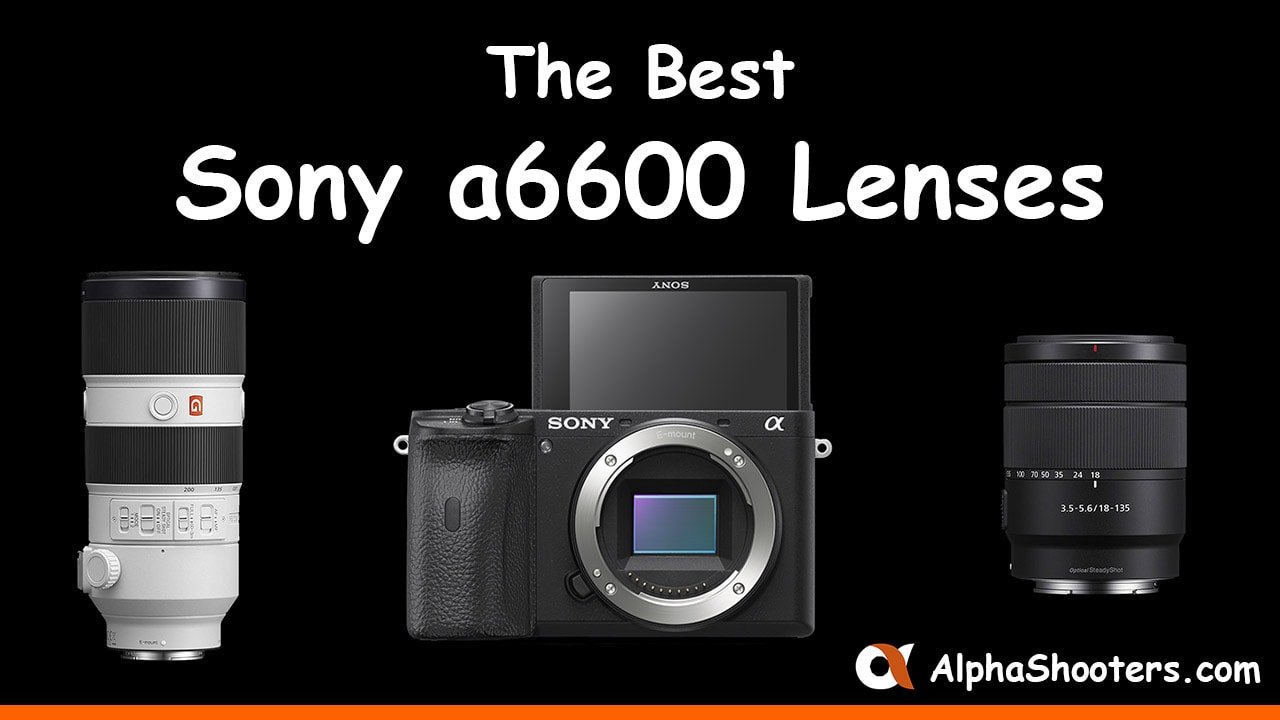
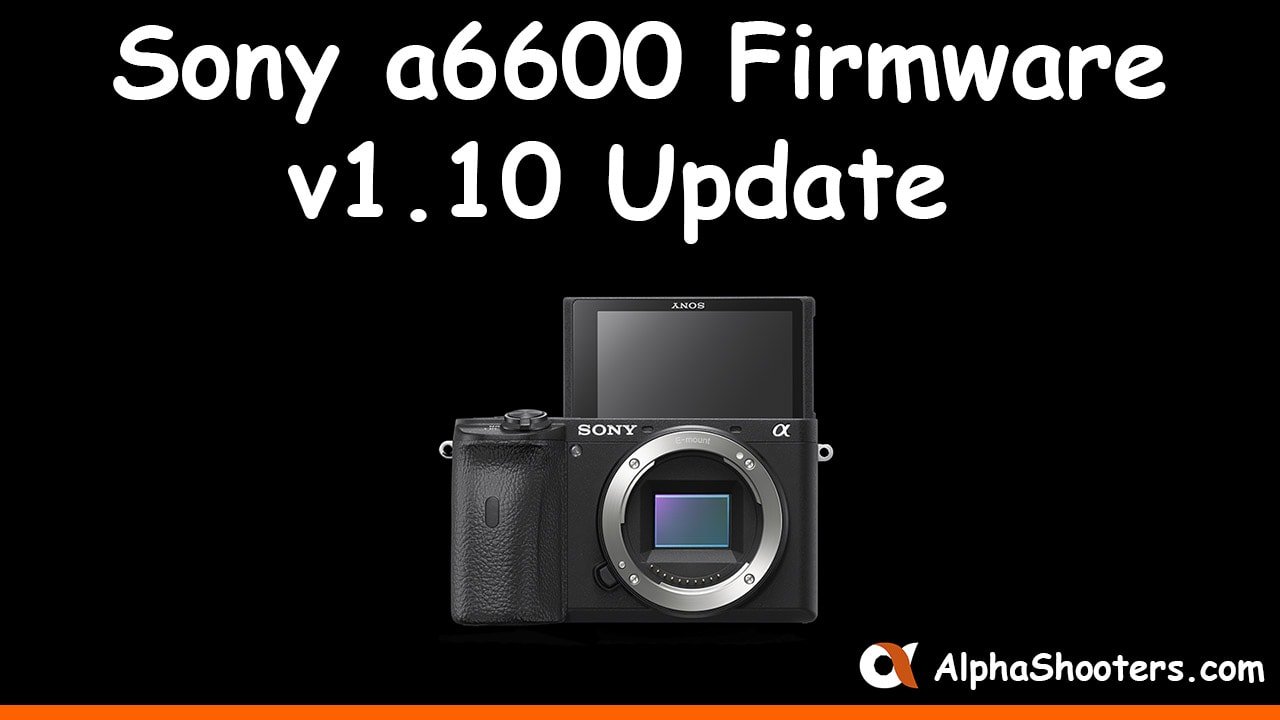


Thanks Timothy. I got the 50mm F1.8 for portraits after reading this. Also planning on getting the 55-210mm telephoto later on. But I’m trying to decide on what’s best option for a wide angle, or any option for group shots/selfies. I’m leaning towards the Sigma 16mm f1.4. Any suggestions? Would it somewhat negate the purpose of the 50mm?
You definitely can’t go wrong with the Sigma 16mm F1.4, it will make a good option for group selfies when you can’t place the camera far enough away for the 50mm to fit everyone in. I don’t think it will negate the need for the 50mm but it will really come down to what you are shooting.
Thanks Timothy, just about to purchase and this was really useful!
Glad that it helped Ian and happy new year to you!
Excellent! and very timely information. Thanks so much Timothy! Now just trying to decide between SonyE 16-55 F2.8 and 18-135 F3.5-5.6….New at this, need adaptable lens while learning..love sunsets/animal shots/and travel shots. So happy to have found your site
Glad that you found it useful Kelly. Both are great lenses. If you need the low light performance then the 16-55 F2.8 will be your best choice, the 18-135 is going to give you a lot more reach but you’ll lose some of the low light performance and the creamy bokeh.